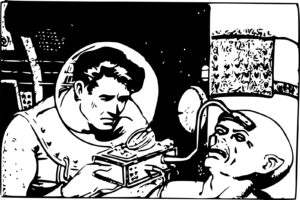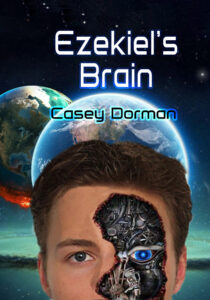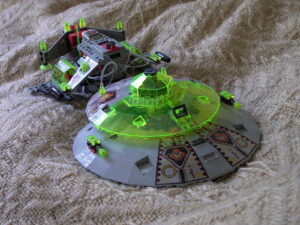In her book, Artificial You, philosopher and author, Susan Schneider says that if Aliens visit Earth, they will most likely be artificial intelligences. What’s more, they may well be non-conscious artificial intelligences. Her reasoning is that the distance between star systems in our galaxy is so great that it is unlikely that organic creatures could survive a trip (in scifi books and films this problem is usually overcome by cryogenic freezing of the spaceship’s occupants for the majority of the voyage). A civilization advanced enough to send a probe to another star system would also be sophisticated enough to construct an AI to pilot the ship and carry out the mission (note that virtually all of our probes to outer solar planets are unmanned).
Her reasoning is that the distance between star systems in our galaxy is so great that it is unlikely that organic creatures could survive a trip (in scifi books and films this problem is usually overcome by cryogenic freezing of the spaceship’s occupants for the majority of the voyage). A civilization advanced enough to send a probe to another star system would also be sophisticated enough to construct an AI to pilot the ship and carry out the mission (note that virtually all of our probes to outer solar planets are unmanned).
But why would such an AI not be conscious? Schneider’s reasoning is that consciousness is not required in order to be intelligent, and the extra energy demand needed to invest an AI with consciousness would not be worth the effort. As I said in my last post, Is Consciousness an Epiphenomenon, I agree that consciousness not only is not necessary for an entity—either machine or organic—to be intelligent, but also that when it is present, it does not play a role in determining behavior. Consciousness is real, but it is simply our awareness of the outcomes of our brain operations, and being aware of them allows us to communicate them to others, which in a group, helps us to predict each other’s behavior.
So how would I construct an alien? First, you may ask, why would I want to construct an alien and, in fact, what does constructing an alien even mean? I’m writing a sequel to my near- (could be, might be, someday it’s within the realm of possibility it will be) best-selling novel, Ezekiel’s Brain. In the sequel, the crew of the spaceship Delphi, who are AIs from our solar system, arrive at a distant planet inhabited by a race of humans but on which there are aliens who appeared on the planet decades earlier and are mysterious, never actually seen, beings known as Snatchers, because they kidnap children and keep them for several years before letting them go. My job, as the author, is to create the Snatchers.
In the sequel, the crew of the spaceship Delphi, who are AIs from our solar system, arrive at a distant planet inhabited by a race of humans but on which there are aliens who appeared on the planet decades earlier and are mysterious, never actually seen, beings known as Snatchers, because they kidnap children and keep them for several years before letting them go. My job, as the author, is to create the Snatchers.
I took to heart, Susan Schneider’s conjecture that alien visitors would be AIs not organic creatures. After all, the Delphi’s entire crew (except one human who is not from earth that they added to their crew), are AIs who travel from star system to star system. But if there is more than one Snatcher, then they have to communicate. In fact, if there is more than one of them, that means piloting their ship must have been a cooperative group effort. I tried to imagine how non-conscious beings could communicate with each other. I assumed that they could not have a language as we do, although that might not be true. I thought about bees, who communicate by choreographed movements, and flocks of birds of schools of fish, who move in graceful, often complex patterna. It turns out that, at least in some birds, any particular bird picks up information (it’s not clear how) from its nearest neighbors and they all perform the same movement at once. The movement of the entire flock may be initiated as a reflex by one bird on the periphery in response to detection of a predator. Almost immediately, the entire flock makes the same movement.
But if there is more than one Snatcher, then they have to communicate. In fact, if there is more than one of them, that means piloting their ship must have been a cooperative group effort. I tried to imagine how non-conscious beings could communicate with each other. I assumed that they could not have a language as we do, although that might not be true. I thought about bees, who communicate by choreographed movements, and flocks of birds of schools of fish, who move in graceful, often complex patterna. It turns out that, at least in some birds, any particular bird picks up information (it’s not clear how) from its nearest neighbors and they all perform the same movement at once. The movement of the entire flock may be initiated as a reflex by one bird on the periphery in response to detection of a predator. Almost immediately, the entire flock makes the same movement.
Flock or school behavior didn’t seem apt for communication among members of a crew on a starship. There would be no sense in having everyone behave the same way. I next examined direct sensing between AIs of patterns of activation across neural networks. It would be like scifi scenarios, or Elon Musk’s goal, of machines that can read thoughts directly from our brains by picking up the pattern of electrical charges moving through circuits of neurons. At first glance, it seems this would require a translator. What good would knowing what the pattern of neural firing were if we couldn’t translate them into thoughts? But that was me thinking in terms of consciousness. If one brain—artificial or organic—used the same pattern of neural firing as another brain did, then sensing that pattern would immediately tell it what the other brain was thinking. But this assumes a within-species universal “language of thought” in terms of using the same patterns of neural firing for similar thoughts. That’s what language is for us, at least at some deeper level than regional languages and dialects.
At first glance, it seems this would require a translator. What good would knowing what the pattern of neural firing were if we couldn’t translate them into thoughts? But that was me thinking in terms of consciousness. If one brain—artificial or organic—used the same pattern of neural firing as another brain did, then sensing that pattern would immediately tell it what the other brain was thinking. But this assumes a within-species universal “language of thought” in terms of using the same patterns of neural firing for similar thoughts. That’s what language is for us, at least at some deeper level than regional languages and dialects.
Without requiring that they be identical, similar patterns of neural network firing (either in AI brains or organic brains) could be correlated with behaviors in much the same way we correlate patterns of speech with behaviors when we learn what patterns of speech mean. We don’t all use exactly the same pattern to express the same thought, but we quickly learn how to interpret different variations of an idea similarly. The same could be done by sensing another’s pattern of neural firing. In essence it becomes a language. The difference is that we can’t decide not to express it. Whatever is thought can be sensed by another being so long as they have the ability to directly sense neural patterns in others.
So now I have one possibility for my aliens. They are AIs that directly sense each other’s brain workings. The next step is to decide whether the organic creatures who created them a) are still surviving on some distant planet or have become extinct, and b) are they conscious beings or do they operate like the AIs they sent on this mission? Additionally, I have to figure out how the Delphi crews learns how these alien Snatchers communicate and if they can establish any type of communication with them, as well as if they are friendly. I’ve got some ideas. Lots of fun.
Ezekiel’s Brain may be purchased through Amazon by clicking HERE.
Want to subscribe to Casey Dorman’s fan newsletter? Click HERE.




